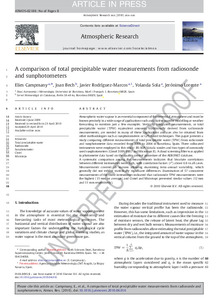Por favor, use este identificador para citar o enlazar este ítem:
http://hdl.handle.net/20.500.11765/2009
A comparison of total precipitable water measurements from radiosonde and sunphotometers
Registro completo de metadatos
| Campo DC | Valor | Lengua/Idioma |
|---|---|---|
| dc.contributor.author | Campmany, Elies | es_ES |
| dc.contributor.author | Bech, Joan | es_ES |
| dc.contributor.author | Rodríguez Marcos, Francisco Javier | es_ES |
| dc.contributor.author | Sola, Yolanda | es_ES |
| dc.contributor.author | Lorente, Jerónimo | es_ES |
| dc.date.accessioned | 2016-04-20T09:15:44Z | - |
| dc.date.available | 2016-04-20T09:15:44Z | - |
| dc.date.issued | 2010 | - |
| dc.identifier.citation | Atmospheric Research. 2010, 97(3), p. 385-392 | es_ES |
| dc.identifier.issn | 0169-8095 | - |
| dc.identifier.uri | http://hdl.handle.net/20.500.11765/2009 | - |
| dc.description.abstract | Atmospheric water vapour is an essential component of the terrestrial atmosphere and must be known precisely in a wide range of applications such as radiative transfer modelling or weather forecasting to mention just a few examples. Vertically integrated measurements, or total precipitable water (TPW) equivalent amounts traditionally derived from radiosonde measurements, are needed in many of these applications and can also be obtained from other methodologies such as sunphotometers or GPS-based techniques. This paper presents a study comparing different measurements of TPW from radiosonde and sunphotometer data recorded from 2001 to 2004 in Barcelona, Spain. Three collocated instruments were employed in this study: RS-80A Vaisala sondes and two types of commonly used sunphotometers (Cimel 318N-VBS7 and Microtops II). A cloud screening filter was applied to photometer data based on the quality control procedure of the AERONET database. A systematic comparison among the measurements indicates that bivariate correlations between different instruments were high, with correlation factors (r2) above 0.8 in all cases. Measurements covered all seasons allowing examining intra-annual variability, which generally did not exhibit statistically significant differences. Examination of 57 concurrent measurements of the three instruments indicated that radiosonde TPW measurements were the highest (15 mm on average) and Cimel and Microtops presented similar values (12 mm and 11 mm respectively). | es_ES |
| dc.description.sponsorship | This work was supported by the Spanish Ministry of Science and Technology under the project DAMOCLES ‘Aerosols characterization by columnar (lidar and extinction) and “in situ” measurements’ (REF: CGL2005-03428-C04-04). | - |
| dc.format | application/pdf | - |
| dc.language.iso | eng | es_ES |
| dc.publisher | Elsevier | es_ES |
| dc.rights | Licencia CC: Reconocimiento–NoComercial–SinObraDerivada CC BY-NC-ND | es_ES |
| dc.subject | Total precipitable water | es_ES |
| dc.subject | Radiosonde | es_ES |
| dc.subject | Sunphotometer | es_ES |
| dc.subject | Cimel | es_ES |
| dc.subject | Microtops | es_ES |
| dc.title | A comparison of total precipitable water measurements from radiosonde and sunphotometers | es_ES |
| dc.type | info:eu-repo/semantics/article | es_ES |
| dc.relation.publisherversion | http://dx.doi.org/doi:10.1016/j.atmosres.2010.04.016 | es_ES |
| dc.rights.accessRights | info:eu-repo/semantics/openAccess | es_ES |
| Colecciones: | Artículos científicos 2010-2014 | |
Ficheros en este ítem:
| Fichero | Descripción | Tamaño | Formato | ||
|---|---|---|---|---|---|
| Campmany_et_al_2010.pdf | 775,24 kB | Adobe PDF |  Visualizar/Abrir |
Los ítems de Arcimis están protegidos por una Licencia Creative Commons, salvo que se indique lo contrario.





